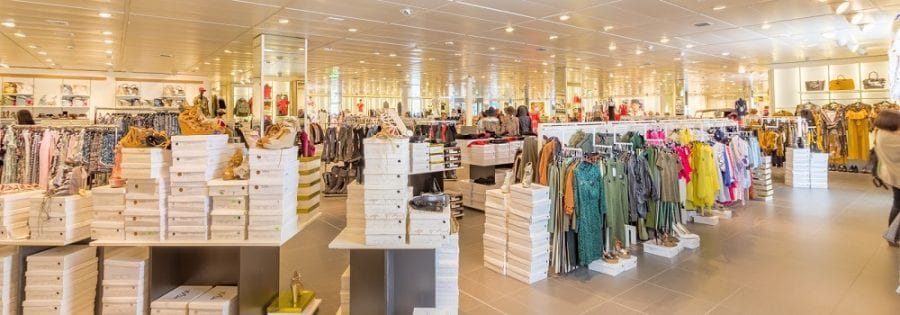
Archive
Looking Ahead at 2020 Retail Trends
Written by: Parcel Pending
7 Min Read
Published: January 21, 2020
Updated: September 2, 2021
2020 begins a new decade. A decade that will be defined by retail innovation across the board and consciousness across all demographics. As people collectively set a ten-year plan into their sights, retailers will have to adapt to the growing trends that could mean the difference between a booming business or an “everything must go” sign.
These 2020 retail trends are exactly the focus needed to think tactically about in the year to come, so the business can stay one step ahead of the competition in the retail industry. Because one thing is certain in 2020: people will continue to spend their hard-earned money.
What Retailers Need to Know for 2020
For better or for worse, things are changing in retail. Online and offline communities are intertwining more than ever before. Private labels are on everyone’s radar, as experiential retail combines the powers that be into a new decade defined by innovative retail tech and a novel customer shopping experience.
Retailers are stepping up their game to give the consumer a more meaningful shopping experience. However, it’s more than just being a forward-thinking retail business. It’s about results.
2020 Retail Trends
Understanding these 2020 retail trends ensures a competitive edge every retail business needs heading into the next economic decade. Combined with statistics and analysis, these strategies will prove extremely valuable to a successful start in 2020.
- Circular Economy – The circular economy really comes down to a simple maxim: less waste, more profit. 2020 will be the first year for a decade defined by consciousness. Every year, people have been watching the Amazon fires, read statistics on ocean pollution, and participate in climate change discourse. It’s time for retail businesses to help reduce our carbon footprint and adopt a mantra of using recycled materials whenever possible.
This can be as simple as adopting paper bags over plastic or something more complex, like offering a discount to people who donate recyclable fabrics. When minimizing waste and promoting sustainability, the retail store stands for something greater, appealing to conscious young people who are naturally looking for more positive alternatives. A study from OC&C Strategy Consultants, revealed 15% of Gen Z respondents are dedicated to “reducing the amount of waste they create.”
- Social Media Retail – For a lot of retail businesses, their social media strategy doesn’t go much farther than daily posts and a few weekend sales. This strategy is sure to come up short in the new year. 2020 will see an immense integration of tech trends in the customer shopping experience. And one of those integrations will be “InstaShopping,” or using social media platforms like Instagram to levy data of shoppers and to communicate with their base to expedite the retail shopping experience.
Instagram has already reported that 60% of its users or (600 million for every 1 billion monthly users) currently use the platform to find and purchase products. According to GlobalWebIndex, 28% of users search for products on social media. These are demographics and numbers retailers will want to strategize not only for 2020 but for years to come.
- Community-Building & Participation – In 2020, people will be craving authentic and meaningful connections more than ever. And the same goes for the businesses and establishments they choose to support. People are constantly being advertised to and being told of the latest retail trends, so in the end, everyone is looking for ways to add more meaning to their shopping experience.
Retailers are always looking for ways to set themselves apart from the big chains and e-Commerce competition. One of the best ways is by focusing on community building and participation. Maybe that’s as simple as hosting a Thanksgiving food drive or sponsoring a local youth baseball team like Big 5 Sporting Goods, or maybe it’s focusing the retail business around the needs of the local community.
- Private Label Sales – Again, 2020 will be defined by consciousness. People want to know who and what their dollar is supporting. A trend that has been steadily increasing is the rise of private label growth in the retail sector. This is what big chains like Target dub “owned brands.”
Essentially, these are the wide-ranging category brands that offer a personalized brick and mortar product, often with higher quality and more intangibles than those labels that have been around for decades. When traditionally private labels offered themselves as cheaper, humbler alternatives, research from the NDP Data Group has illustrated the rise in premium private labels as well. A trend surely on pace to continue into 2020 and beyond.
- Payment Flexibility – Does the business take Venmo? Okay, what about CashApp? Apple Pay? Paypal? Or maybe Zelle? Retailers probably heard all of these and more, over recent years. The truth is, there are more ways to pay today than ever before. In fact, according to a data report from Juniper Research, 2.1 billion consumers worldwide are expected to use a mobile payment or mobile money transfer in 2020.
The last thing to know heading into 2020, especially if appealing to Gen Z and Millennials, is for retail businesses to gain a rep of “cash only.” The trend of mobile payments is only going to continue. Keep the business ahead of the game with increased payment flexibility.
- Subscription-Based – Not every trend is going to be applicable in 2020 for brick and mortar stores. While subscription-based services and e-Commerce subscription boxes have been steadily increasing since 2016, there are several key challenges for subscription-based capital that general retail overcomes. The product variety is the primary factor consumers chose to subscribe or not-subscribe for recurring products.
According to a survey conducted by McKinsey, 1 in every 2 customers signed up for a subscription service in 2016. Consider how retail businesses can get in on the recurring capital model, finding new affordable, personalized ways to supply consumers with what they need.
- Social Impact & Responsibility – With every new decade comes to a new wave of thinking. 2020 will certainly be defined by a shift in retail consciousness. According to research conducted by CONE Communications, 87% of Americans purchased a product because said company advocates for an issue they cared about, while 76% of Americans refused to purchase a product by said company because that company supported an issue contrary to their beliefs.
Simply put, people care more about the social impact and responsibility of a product now more than ever. And this trend is only going to continue. It is not a question of should the company stand up against social injustices, but how to do so in a way that is socially responsible.
- Health and Wellness – According to a report published by TechNavio, the global natural and organic personal care market will grow by $8.3 billion USD from 2019 to 2023, or to a whopping $17.6 billion by 2021. It’s imperative for retail businesses to incorporate the various aspects of self-care into the retail and omnichannel commerce strategies. Understanding consumer behavior is the first step to connecting with them on a deeper level. Health is wealth after all.
The Future of Retail?
The future of retail is a future defined by technology. While fashion trends are harder to anticipate, trajectories of how people interact with technology to purchase retail are pretty spot on. Instashopping, deep-retail, voice search, and artificial personal assistants are all focal points to the retailer’s future strategies.
YouGov, through analyzing amazon eCommerce trends, predicts smart speaker adoption will increase from 14% to 27% in just one year (2019-2020). While companies like Gartner predict 30% of Google searches will be conducted with no phone or computer screen at all. Combining these novel experimental customer shopping experiences into the strategy with the rise of a 5g network ensures retail businesses stay ahead in these categories.
These technological advances are not only what makes a customer’s shopping experience seamless, but they also create new ways for customers to be participants in the brand and products.
How Forward-Thinking Retailers Keep Foot-Traffic at an All-time High
For decades the answer to “why do people want to come into your store?” could be answered by—well—the products. But now, with people having a whole world of shopping at their fingertips, anyone can purchase anything they want online. That being said, to combat the online juggernauts, forward-thinking retailers have been able to keep foot-traffic at an all-time high. But how?
Here are some key ways to increase foot traffic in a retail store:
- Seamless In-Store Experience
- Experimental Customer Shopping Experience
- Premium Private Labels
- Instashopping & 5G Incorporation
Use Parcel Pending to Upgrade the In-Store Experience
The idea is simple: people now want to come into the retail business for the experience. Every day people are yearning for authentic shopping experiences. With their phone in hand to snap a selfie or take a video of “you gotta see this place,” retailers are thinking of creative ways to increase customers in retail, improve staff efficiency and create an authentic shopping experience.
For example, many businesses like Dick’s Sporting Goods, are offering BOPIS, or Buy Online and Pick Up In-Store. By utilizing Parcel Pending smart lockers, customers can buy their goods online and simply scan their phones at the lockers to receive their purchases.
It’s this type of convenience and dedication to the customer experience that businesses in the industry are focusing on. And in 2020, this focus will only be sharper.
Sources:
- Finances Online. 10 Future Retail Trends & Forecast for 2020 – A Look Into What’s Next. https://financesonline.com/retail-trends/
- Global Web Index. The Ecommerce Trends to Know. https://www.globalwebindex.com/reports/commerce
- Vend. Vend’s Retail Trends & Predictions 2020. https://www.vendhq.com/retail-trends-and-predictions
- Retail Dive. H&M is Ready for Gen Z. https://www.retaildive.com/news/hm-is-ready-for-gen-z/552826/
- Tech Novio. Global Natural & Organic Personal Care Product Market 2019-2023. https://www.technavio.com/report/global-natural-and-organic-personal-care-product-market-industry-analysis
- Cone. Americans Willing to Buy or Boycott Companies Based on Corporate Values.
- https://www.conecomm.com/news-blog/2017/5/15/americans-willing-to-buy-or-boycott-companies-based-on-corporate-values-according-to-new-research-by-cone-communications
- NPD. How Private Label Goes Premium. https://www.npd.com/wps/wcm/connect/npd/d2b29f28-684e-4664-bad6-67d7ee640423/PrivateLabel_Whitepaper.pdf?MOD=AJPERES&CONVERT_TO=url&CACHEID=ROOTWORKSPACE.Z18_520I1882LOEKB0A9ALRD9K0000-d2b29f28-684e-4664-bad6-67d7ee640423-mKlP7R7
- Business Wire. QR Code Payments Soar in China but Face Challenges Elsewhere.https://www.businesswire.com/news/home/20180404005093/en/Juniper-Research-PayPal-Heads-Mobile-Wallet-Rankings
- McKinsey & Company. Thinking Inside the Subscription Box: New Research on E-Commerce Consumers . https://www.mckinsey.com/industries/technology-media-and-telecommunications/our-insights/thinking-inside-the-subscription-box-new-research-on-ecommerce-consumers



